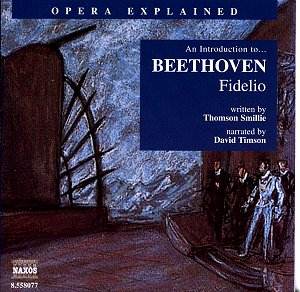The Naxos ‘An Introduction to …’ series is an
inexpensive way to be guided, intelligently, around the mainstays
of the operatic repertoire. Aida, Carmen, Rigoletto,
Tosca, La traviata, Fledermaus are but some
of those on offer. In this case the spoken text is smattered with
musical extracts drawn from Michael Halász’s critically
well-received Naxos recording (8.660070/1).
Actor David Timson is our well-spoken guide.
He has already appeared as part of Naxos’s spoken word catalogue,
having recorded six volumes of the Sherlock Holmes adventures.
He is also narrator for the Naxos Stravinsky Soldier’s Tale.
The text itself is by Thomson Smillie, whose operatic credentials
include stints at Wexford, Opera Company of Boston and general
director of Kentucky Opera.
The product opens with the final chorus of praise
to Leonore from the Naxos recording (a ‘Hymn to Joy’, which promptly
appears; alas, in not such an uplifting performance, to be followed
by the close of the Choral Fantasy, in Toscanini’s 1939
recording). Background is interesting and accurate, referring
to the value of Beethoven’s copious sketchbooks as clues to genesis.
The ‘Leonore’ overtures are, of course, mentioned: including the
use of Leonore No. 3 in Act 2 (which the Naxos recording ‘of course’(!)
omits).
The discussion of the actual ‘Fidelio’ overture
is informed and clear, correctly pointing out the suitability
of the final choice, the Fidelio Overture (it does not
overbear the domestic scene after the curtain has risen). Timson
gives a strange musical mnemonic for the opening: when Smetana
came to Western Europe, people referred to him as ‘Monsieur Smetaana’,
to which he would reply ‘No, no, like Fidelio pronounce’ and then
sing his name to the rhythm of the opening bar. The opening duet
raises a couple of questions: Jaquino is pronounced with the initial
‘J’, and why does he, when he sings, omit ‘Wir können’ from
his statement?.
Nevertheless, there is much to enjoy. The performance
of the Act I Quartet is referred to as from the ‘realms of the
sublime’. Quite right: this is music delivered straight from Heaven,
and this is indeed a lovely performance (enough to persuade many
listeners to buy the complete set on the strength of this alone,
probably). Rocco’s money aria is superb (it comes in the shape
of Kurt Moll, no less!).
Some of the discussion is fascinating (Abscheilicher!
is a prime example). The examination of Act II Scene 1, however,
degenerates more into the ‘this happens, then that happens …’
mode. Leonore’s moments are a delight to hear (it is, after all,
Inge Nielsen in the starring role), whereas Florestan, Gösta
Winbergh, has a tendency to shout.
Certainly this is a recommendable product to
anyone who wishes to be initiated into one of the greatest hymns
to love and humanity ever penned. Then all you need to do is buy
the opera itself.
Colin Clarke

